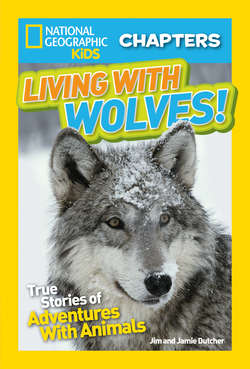Читать книгу National Geographic Kids Chapters: Living With Wolves!: True Stories of Adventures With Animals - Jim Dutcher - Страница 8
ОглавлениеAs a puppy, Kamots was very curious. Here he nibbles on a log to see what it tastes like.
Kamots wanted to explore everything. He and the other pups blew through the tent like little hurricanes. They snatched clothes, straps, tools, shoes—anything that wasn’t nailed down. In minutes, they had chewed them to bits!
It was time for them to move out of the tent. But they were still too small for the big territory.
“What should we do with them?” I asked my crew. “They need a safe place.” Then I figured it out. We fenced in an area just outside the yurt. That way we could keep an eye on them. And there would be fewer things for them to chew on. Of course, there was always the bottom of my shirt to nibble. And sometimes … Ouch! That was my finger!
Did You Know?
A wolf has 42 very sharp, curved teeth. These help the wolf hold on to its prey. The wolf’s canine teeth can be an inch (2.5 cm) long.
Within a few months, I knew they were ready for the big enclosure. I felt like I was sending my kids off to school for the first time. I fumbled with the latch while the pups jumped up and whined with excitement. I opened the gate, and they charged out. Guess who was right out in front? Kamots.
Kamots was fearless. He hopped onto a log and walked along it, like a tight-rope walker. When he was tired of that game, he wanted down. Jumping off was scarier than hopping on. But he only hesitated for a second. I could see that he had the gift of confidence.
The other pups followed Kamots around like he was in charge. I wasn’t really surprised. I had noticed that Kamots was braver and more curious right from the start—a natural leader.
Every wolf pack needs a leader. The lead wolf is called the alpha (sounds like AL-fuh). He’s like the captain of a ship. He goes first when they explore. If he senses danger, he makes sure the other wolves are safe before taking care of himself.
Before long, I saw other signs that Kamots was the alpha wolf. He howled first, keeping his head higher than the others when he did. Arroooo! And he was the first to greet human visitors. But the most astonishing sign came as soon as I began feeding the wolves like they were in the wild.
I fed them raw meat every three to five days. I talked to local officials. They allowed me to find dead animals that had been hit by cars. That way they wouldn’t go to waste, and the wolves would have food to eat. Kamots ran to the food first.
But when the other wolves tried to join him, he glared at them and bared his teeth. He snarled and flattened his ears. Even his brother, Lakota, had to wait his turn. I was shocked to see Kamots act like this. But then I understood. The alpha says who eats when. By telling the other wolves to wait, Kamots was telling them that he was in charge.
Did You Know?
Wolves have super hearing. They can hear sounds as far away as 10 miles (16 km) in open areas. And they can hear high-pitched sounds that humans can’t!
When Kamots growled at the others, he was acting like a parent scolding a child. There are a lot of ways a wolf pack is like a family. I once heard about a wolf that was kicked in the jaw by a moose. His jaw was broken, and he couldn’t chew meat. His pack chewed up food and fed it to him. Like a human family, they took care of a hurt member.
Wolves howl for a lot of reasons. It doesn’t seem to matter if the moon is out or not. Why do they howl? Sometimes it’s to call to each other. Sometimes it’s because they have a full belly. Often they howl because they enjoy it—it’s like singing for them. Each wolf has a unique sound. We learned to identify which wolf was howling. We thought that Lakota had the prettiest howl. Wolves start howling when they are pups. But it sounds more like yodeling!
Only once did I ever see Kamots outsmarted. It was at dinnertime. And it took two wolves to do it. One wolf crept up, snatched a very small piece of meat and scampered off. His partner in crime waited his turn. As soon as Kamots ran after the first wolf with the meat, the second wolf lunged and grabbed a bigger chunk of meat. The second wolf raced off in the opposite direction. Kamots saw him out of the corner of his eye and chased him. Meanwhile, the first wolf ran back to dinner and grabbed an even larger hunk. Kamots never fell for this trick again!
